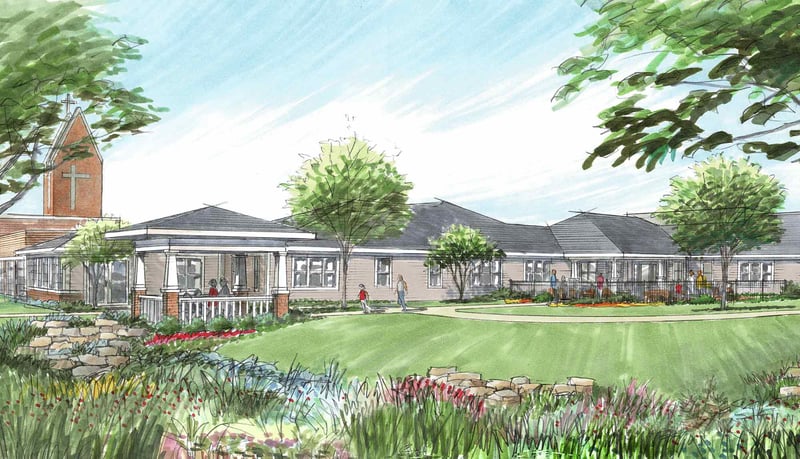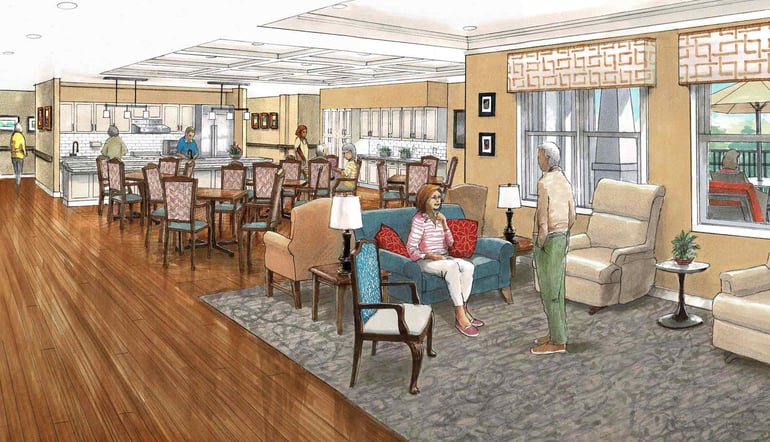
Many Louisville families looking for a care provider for their older loved ones begin their search without a clear understanding of the various types of care available to them. Assisted living communities, for example, are different from modern personal care homes (PCHs), which in turn are different from most people’s conception of a traditional nursing care center.
Continuing care retirement communities (CCRCs) like Episcopal Church Home combine elements of all three. They offer several levels of senior care, allowing residents to progress along the aging continuum without having to move to a new home.
Let’s compare and contrast the different kinds of retirement homes to give you a better idea of which might be the best fit for your aging loved one’s current and future needs.
Understanding the Levels of Senior Care
Retirement communities function on a social care model
Often, as seniors age, they begin to feel lonely. Their children move away and start their own families, sometimes in towns far away. Friends move away or pass on. After retirement, they may rarely see their former colleagues, with whom they spent a significant part of their working lives. And when a partner passes away, a widow or widower often feels isolated.
Retirement communities, or senior communities, are just that: communities where older people live. Retired persons can live near, meet, and socialize with people their own age.
This benefit shouldn’t be overlooked from a health standpoint. Research has indicated that seniors who maintain an active, healthy social life are less likely to experience depression, memory problems, and even early-onset dementia.
Assisted living communities provide help with the tasks of daily living
Slightly more toward the medical management side of the senior care continuum is assisted living. But let there be no misconception here: An assisted living community is not a skilled nursing care center. They’re even licensed and regulated differently by the Commonwealth of Kentucky.
Seniors living in assisted living communities tend to need just a little help with things the rest of us accomplish on our own. They might need transportation because they no longer drive. They may need help bathing, dressing, cooking or cleaning. They may need management or gentle monitoring of their medication routine, but otherwise, they’re still living quite independently.
Assisted living residents benefit from having help nearby when they need it. They don’t receive 24-hour nursing care or round-the-clock personal care.
Personal care homes aren’t the “nursing homes” of yesteryear
True, PCHs provide licensed nurses, and their residents receive medical monitoring.
Residents of personal care homes aren’t helpless or bedridden, and they’re not shut-ins. They’re just seniors who need stronger support to stay as healthy and active as possible.
Personal care homes provide social opportunities. They plan outings and events for their residents. Most modern PCHs feel “homey.” They have bright, cheery interior decorations and plenty of natural lighting, and they don’t feel at all clinical.
Most provide basic health services and medication management but don’t provide advanced life support. Residents often have their own apartments or private rooms within the community and are free to move about their days as they see fit.
At ECH, there is a household on the same campus that is dedicated to personal care for people living with Alzheimer’s disease or other memory loss. There is stepped-up monitoring for their safety, but they are free to move about common areas, socialize, enjoy activities, and live their lives as normally as possible.
CCRCs blend all three care types
In a CCRC, seniors might begin retirement living completely independently in their own cottage or apartment. Spouses, of course, live together. It’s a bit like living in a condominium complex, except everyone in the neighborhood is an elder.
As medical needs change, a CCRC resident may begin receiving assisted-living-type services in their home or can move to another area in the same community that can provide personal care for more medical monitoring.
Couples with differing medical needs may live on different wings, but they don’t need to live far apart, in separate facilities. This makes transitioning between the different levels of care easier for them and minimizes disruption to seniors’ daily lives when the need for more medical care becomes necessary.
A Bold Vision for the Future
See the difference residential retirement care could make in your older loved one’s life.
Here at Episcopal Church Home (ECH) in Louisville, residents enjoy just the right level of care they need, wherever and whenever they need it. We provide person-centered, dignified care for seniors and much-needed peace of mind for their family caregivers.
As part of our Master Plan, ECH is constructing new personal care apartments which will better meet the desires of seniors who have become accustomed to larger spaces and more amenities. We’re also creating a more intimate environment for residents with cognitive loss who require personal care services.
Pictured below: A rendering of the new personal care apartments at the Episcopal Church Home.
 Pictured below: A rendering of the interior of ECH's new personal care apartments.
Pictured below: A rendering of the interior of ECH's new personal care apartments.

The new Memory Care Center of Excellence features two neighborhoods with a suite of memory support services developed by ERS to keep residents stimulated and engaged. Our Living Well Memory Support services feature programs such as art, music, cognitive and physical therapies that are designed to meet their person-centered needs daily.
If your senior loved one might benefit from independent retirement living, assisted living, personal care, or residential memory care, we invite you to come see our community. Click here to schedule a tour today.
Editor's Note: This blog was originally published on June 7, 2016, and has been rewritten and republished with more up-to-date information.












